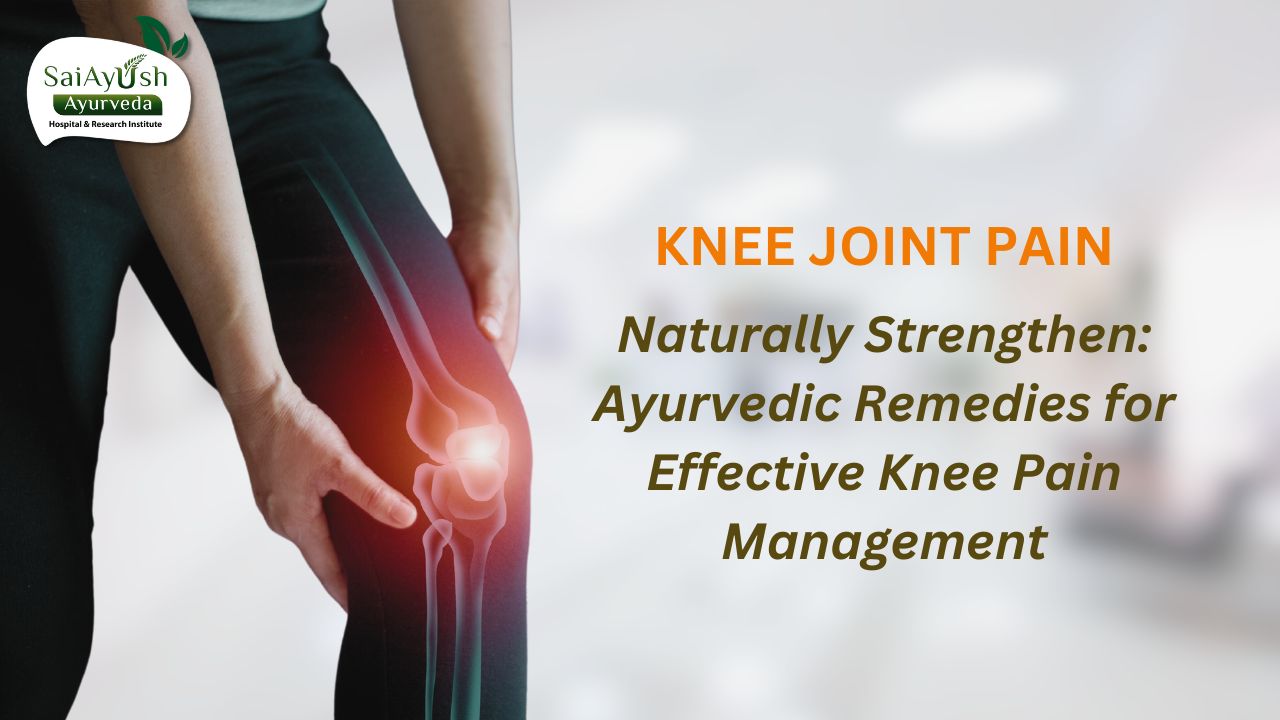Introduction to Knee Joint Pain
In today’s fast-paced world, knee joint pain has become a common ailment affecting people of all ages. Known as “Sandhigata Vata” in Ayurveda, this condition is believed to result from an imbalance in the Vata dosha, leading to pain, stiffness, and reduced mobility in the knee joint. In this blog, we will explore the causes, risk factors, symptoms, diagnosis, and Ayurvedic treatmentoptions for knee joint pain.
Understanding Knee Joint Pain
The knee joint is a complicated structure made up of bones, ligaments, tendons, and cartilage. When any of these components are affected, it can lead to knee joint pain. Some common causes include:
Causative Factors:
- Vata Imbalance: According to Ayurveda, an aggravation of the Vata dosha is the primary cause of knee joint pain. Factors such as aging, excessive physical exertion, and a sedentary lifestyle can contribute to Vata imbalance.
- Injury or Trauma: Sports injuries, accidents, or falls can damage the structures within the knee joint, leading to pain and discomfort.
- Obesity: Excess weight puts additional stress on the knee joint, increasing the risk of pain and degenerative conditions like osteoarthritis.
- Lack of Exercise: Insufficient physical activity weakens the muscles surrounding the knee joint, making it more prone to pain and injury.
- Poor Posture: Incorrect alignment of the knee joint due to poor posture or improper body mechanics can cause pain and discomfort over time.
Who is at Risk?
While knee joint pain can affect anyone, certain factors increase the risk:
- Age: As we age, the natural wear and tear of the knee joint can lead to pain and stiffness.
- Gender: Women are more susceptible to knee joint pain, especially during pregnancy and menopause.
- Occupation: Jobs that involve repetitive stress on the knee joint, such as construction work or professional sports, increase the risk.
- Genetics: Some individuals may have a genetic predisposition to conditions like rheumatoid arthritis or osteoarthritis, which can cause knee joint pain.
Signs and Symptoms:
Recognizing the signs and symptoms of knee joint pain is crucial for early intervention and effective treatment. Look out for the following indicators:
- Pain: Persistent or intermittent pain in the knee joint, ranging from mild to severe.
- Swelling: Visible swelling or inflammation around the knee joint.
- Stiffness: Difficulty in bending or straightening the knee, especially after periods of rest.
- Limited Range of Motion: Reduced flexibility and decreased ability to perform daily activities.
- Cracking Sounds: Audible clicking, popping, or grinding sounds during movement.
- Instability: Feeling of the knee giving way or being unable to bear weight on the affected leg.
Ayurvedic Concept of Knee Joint Pain
According to Ayurveda, knee joint pain is primarily caused by an aggravated Vata dosha. Vata is responsible for movement and controls the nervous system. When imbalanced, it can lead to pain, inflammation, and stiffness in the knee joint. Additionally, the accumulation of Ama (toxins) in the joints can further exacerbate the condition.
Treatment and Management in Ayurveda
Ayurvedic treatment for knee joint pain focuses on balancing the Vata dosha, reducing inflammation, and strengthening the affected joint. Here are some key approaches:
- Panchakarma Therapies:
Panchakarma, a set of Ayurvedic detoxification therapies, is often recommended to eliminate toxins and restore balance. Therapies such as Abhyanga (herbal oil massage), Swedana (herbal steam therapy), and Basti (medicated enema) can provide significant relief from knee joint pain.
- Herbal Medicines:
The anti-inflammatory and analgesic qualities of Ayurvedic herbs like Shallaki (Boswellia serrata), Guggulu (Commiphora mukul), and Ashwagandha (Withania somnifera) are well known. These plants have anti-inflammatory and pain-relieving properties that enhance joint mobility.
- Dietary and Lifestyle Modifications:
Ayurveda emphasizes the importance of a balanced diet and lifestyle to manage knee joint pain. Including warm, nourishing foods, such as soups, cooked vegetables, and herbal teas, can help pacify Vata. Regular gentle exercise, yoga, and maintaining a healthy body weight are also vital for joint health.
- External Therapies:
External therapies like Janu Basti (localized oil pooling over the knee) and Lepam (herbal paste application) can provide localized relief, reduce inflammation, and improve joint flexibility.
- Ayurvedic Formulations:
Ayurvedic formulations like Maharasnadi Kwath, Yograj Guggulu, and Triphala Guggulu are commonly prescribed to alleviate knee joint pain and promote joint health.
Remember, Ayurvedic treatment should be personalized and carried out under the guidance of a qualified Ayurvedic practitioner. Prioritize your joint health and consult an Ayurvedic doctor to embark on a healing journey towards a pain-free knee joint.
Conclusion
Knee joint pain is a prevalent condition that can significantly impact one’s quality of life. By understanding its causative factors, recognizing the signs and symptoms, and adopting an Ayurvedic approach to treatment and management, individuals can find relief from pain, restore joint function, and improve overall well-being. Embracing a holistic lifestyle, along with Ayurvedic therapies and herbal medicines, can help individuals regain mobility and enjoy a pain-free life.
Note : This blog only offers general information and should not be used to replace consultation with a physician. Please consult a healthcare professional for personalized guidance.



0 Comments